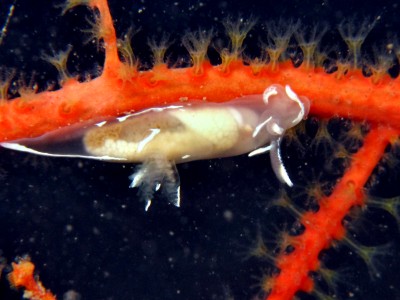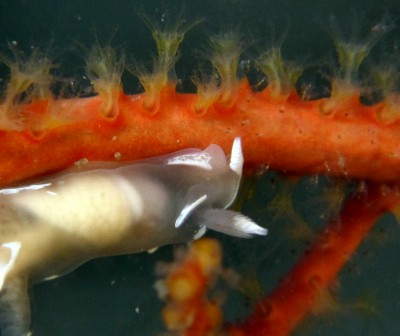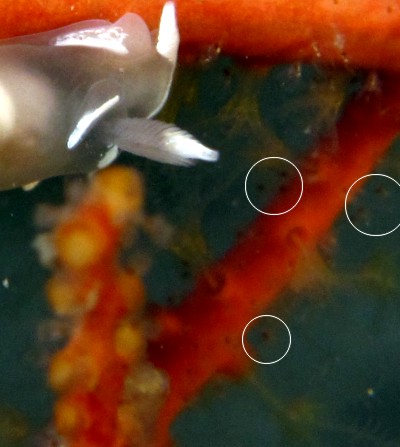Re: Trapania pallida feeding
April 30, 2010
From: Dominique Horst


Concerning message #23180:
Dear Bill,
Thinking about this last message I've try to understand why T. pallida could stay a so long time on Leptogorgia sarmentosa, if its not for feeding on?
Looking carefully on all pictures I did, I'm quit sure that it is feeding on the gorgonian but not on the polyps but on very small polyps that could be entoprocts....
The question is could entoprocts live on gorgonians like they do on Dysidea or other sponges? Maybe you or Bernard Picton may have the answer?
If they do, this would be a clear explanation of the presence of Trapania pallida on L. sarmentosa.
The only other pictures I've seen of T. pallida are those done by Gilles Cavignaux and also on L. sarmentosa. Could this be only a hazard?
Locality: Cagnes, 39 m, France, Mediterranean sea, 30 January 2010, muddy. Length: 5 mm. Photographer: Dominique Horst.
Kind regards,
Dominique
dominique.horst@wanadoo.fr
Horst, D., 2010 (Apr 30) Re: Trapania pallida feeding. [Message in] Sea Slug Forum. Australian Museum, Sydney. Available from http://www.seaslugforum.net/find/23567
Dear Dom,
I agree that your Trapania pallida do seem to spend a lot of time on these gorgonian colonies, but if they were feeding on the gorgonians I would expect to see some sign of them attacking the polyps but the fact that the polyps are fully extended even when the Trapania is nearby - and none appear to be damaged or missing - suggests the gorgonian polyps are not the target. Also the Trapania seem to be on the side of the branch without polyps
Kamptozoans do seems to live in association with various invertebrates, but I am not sure if they have been found with any gorgonian. Bernard may know. However while looking at your hi resolution photos I noticed some dark brown spots which are definitely not holes in the gorgonian colony [see rings]. If you look at the kamptozoa Fact Sheet you will see I find brown spots quite a good indicator of kamptozoa individuals. It wouldn't surprise me if the brown spots in your photos are the stomachs of kamptozoa - then again I could be quite wrong.
Best wishes,
Bill Rudman
Related messages
-
Trapania pallida from French Mediteranean
From: Dominique Horst, April 16, 2010 -
The food of Trapania pallida !!
From: Bernard Picton , February 12, 2001 -
Trapania pallida from England
From: Bernard Picton , February 12, 2001
